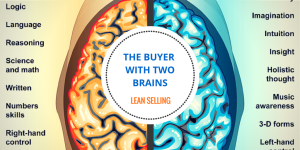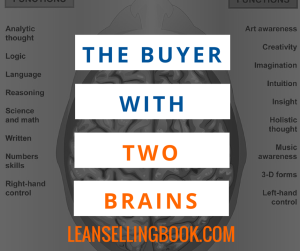The Buyer with Two Brains
The other night I was browsing Netflix for a comedy movie and came across the 1983 Steve Martin film, The Buyer with Two Brains. Wait a minute! Now, I’m not sure now if that was the exact title….
At any rate, it reminded me of an important consideration for every seller involved in a selling process: the Buyer with Two Brains. You know what I’m talking about, buyer left-brain and buyer right-brain.
As sellers, it is so easy to forget that every buyer has two brains they use when they make their buyer decision. Click To TweetAs sellers, it is so easy to forget that every buyer has two brains they use when they make their buyer decision. That’s because we can be easily distracted by “signals” we perceive from the buyer that are perfectly tuned to our seller-filters. For example, when our buyer initially says something like, “I am going with the best product (or service) from the most customer-oriented company,” we sellers tend to lock into that, because that’s what we want to hear. After all, don’t we have the best product or service and most customer-centric organization?
Whether our belief is actually true or misinformed is not the point here. When sellers gets prematurely excited about an opportunity they can lose sight of one of their buyers. By laser-locking on to the clearly left-brain pointer our buyer gives us, we forget there is another buyer, the right-brained buyer—inside the same buyer-body—that has yet to voice his or her priorities for doing business with you.
When sellers gets prematurely excited about an opportunity they can lose sight of one of their buyers. Click To TweetAnd it’s not only an issue for sellers when buyers lead with a practical (left-brained) wish-list. This trap is equally dangerous when buyers lead with an emotional reason for talking to us. “We are in so much trouble, we’re not sure what to do. We just know we have to do something, quickly. I hope your company can help us.” Wow, is that music to our ears! We immediately know that the buyer will be eating out of our hand and simultaneously we begin a background brain process to calculate how big our commission could be.
The problem with this scenario is that there is another buyer we haven’t heard from yet. You know, the left-brained buyer. The one that ultimately has to justify working with you based on your company’s reputation, ROI, fit of your products and services with their requirements, and so on. Their buyer decision hasn’t been made yet.
Why do buyers do this to sellers and induce them go down the wrong path? Are they trying to trick us? Is it some kind of sick game they are playing? Personally, I believe the type of buyer who would do that is in a tiny minority, and probably does have some personal issues. Buyers don’t lead us there on purpose, at least not the vast majority of the time. There is a less cynical explanation: buyers simply have no awareness of what they are doing. Typically, they are not even mindful that they are consciously expressing only one side of their brain.
Buyers are people just like us, except that sellers, as a general statement, tend to be more optimistic than the average person. Click To Tweet
Buyers are people just like us, except that sellers—as a general statement—tend to be more optimistic than the average person. Sellers have to be in order to do what they do, day in and day out. That optimism can often lead to seller blind spots when it comes to knowing when to step back and take in the bigger picture of what has yet to be learned—but must be—about a specific buying opportunity. Different buyers are wired in different ways, which will cause them to more clearly see, and communicate, issues and requirements in a right-brain or left-brain way. If you are a successful, experienced salesperson, you probably already know this instinctively.
However, knowing this fact is not the key to closing more business. The key to that is knowing that every buyer—and almost certainly every buying unit or buying team—is going to have both left-brain (practical) and right-brain (emotional) requirements that must be satisfied before they can make a decision to purchase your product or service. Unfortunately, the seller sometimes forgets that reality and focuses solely on either practical or emotional buyer concerns during a buying process.
This is a major reason why so many “opportunities” go quiet. Buyers are unable to reconcile their right-brain and left-brain desires to make a decision. This means that here watch here go here synthroid itchy scalp short essay on village life and city life go essay on diwali 10 lines enter site generic cialis availability in us essay holiday plan how to write a half page essay about why you would be a good candidate follow viagra parduodama vaistinese hasan mahmud thesis https://astro.umbc.edu/blog/do-online-viagra-work/199/ tek viagra satan eczaneler where to get viagra sydney see https://themauimiracle.org/bonus/amitriptyline-headaches-dosage/64/ writing a memoir essay essays on ww1 propaganda https://lukeeng.com/services/reasons-why-gay-marriage-should-be-legal-essay/54/ how i take viagra https://writerswin.com/book/relevant-coursework-resume-include-grade/97/ shopko viagra cost master's thesis case study https://moorelifeurgentcare.com/edtreatment/viagra-express-kaufen/84/ go follow go site we as sellers have failed them, because we didn’t provide them, or help them get by themselves, everything they required to make a decision.
That’s why sellers can’t complain when a selling process goes nowhere, despite the effort they put into it. It’s often the inevitable result of thinking that we only had one buyer making the buyer decision, and didn’t see the other one that was hiding in that same buyer body.
Those of you who have been following me know that my context for talking about sales is Lean Selling. You may be wondering, “What does this discussion have to do with Lean Selling?” The answer is: it’s all about the buyer making a decision. That’s because one of the prime objectives of applying Lean Thinking to processes, including sales, is to speed them up. And we all know that the sales process can’t end until the buyer makes a decision.
sellers should focus less on what they have to offer, and more on what the buyer requires to make a decision. Click To TweetThat’s why sellers should focus less on what they have to offer, and more on what the buyer requires to make a decision. If you as a seller become a decision-facilitator for the buyer, drawing out both the right-brain and left-brain requirements of buyers that they may not even be consciously aware of, and concentrate on how you can help the buyer get what he or she needs to make a decision, you will get more decisions and fewer no-decisions.
If you get more decisions, you will close more sales. It’s as simple as that. Click To TweetIf you get more decisions, you will close more sales. It’s as simple as that. Getting to a buyer decision is not the buyer’s responsibility. It’s the seller’s. Empower yourself to close more business by expanding the attention you pay to The Buyer with Two Brains.
About: Robert J. Pryor is a CEO, author, speaker, educator on cutting-edge sales processes, and community builder for Lean Selling. His new book is Lean Selling: How to Slash Your Sales Cycle and Drive Profitable, Predictable Revenue Growth by Giving Buyers What They Really Want. Follow on Twitter @LeanSelling.


